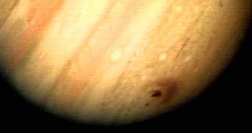

 Comets are often described as dirty snowballs. This isn't a bad description. The nucleus of a comet is made up of fragments of rock, ice and other frozen elements such as methane, ammonia and carbon dioxide. The nucleus is surrounded by a cloud of dust and gas. When a comet approaches the sun the head is illuminated by sunlight and some of the dust and gas is blown away by the solar winds. This creates the characteristic tail.
Comets are often described as dirty snowballs. This isn't a bad description. The nucleus of a comet is made up of fragments of rock, ice and other frozen elements such as methane, ammonia and carbon dioxide. The nucleus is surrounded by a cloud of dust and gas. When a comet approaches the sun the head is illuminated by sunlight and some of the dust and gas is blown away by the solar winds. This creates the characteristic tail.
How fast do comets move across the sky ?
To be honest until I saw my first comet I thought they flashed across the sky and were gone in a few seconds. This is not the case. Comets appear static in the night's sky. Any apparent movement in position over the course of a night is mostly down to the earth's rotation. Over a period of nights the comet will be seen in a slightly different part of the sky as it continues on it's orbit around the sun.
Does the tail always follow behind a comet ?
 Another misconception about comets is that as they hurtle through space the tail follows behind. In fact the tail is caused by the solar winds so it always points away from the sun. This means that as the comet moves away from the sun the tail is pushed out in front of it.
Another misconception about comets is that as they hurtle through space the tail follows behind. In fact the tail is caused by the solar winds so it always points away from the sun. This means that as the comet moves away from the sun the tail is pushed out in front of it.
Who or what are comets named after ?
 Comets are generally named after the person or persons that discovered them. The Hale-Bopp comet that appeared bright in our skies in 1997 was discovered in 1995 by Alan Hale and Thomas Bopp. Many comets are discovered by amateur astronomers. While the most powerful telescopes are focused on specific objects at very high power, it is the thousands of amateurs using smaller telescopes to scan the skies that usually see new comets for the first time. Astronomy is the last area of science where amateurs can make major scientific contributions from their own homes.
Comets are generally named after the person or persons that discovered them. The Hale-Bopp comet that appeared bright in our skies in 1997 was discovered in 1995 by Alan Hale and Thomas Bopp. Many comets are discovered by amateur astronomers. While the most powerful telescopes are focused on specific objects at very high power, it is the thousands of amateurs using smaller telescopes to scan the skies that usually see new comets for the first time. Astronomy is the last area of science where amateurs can make major scientific contributions from their own homes.
Is earth in danger of colliding with a comet ?

The chances of earth being hit are very remote. Comets are very few in number in the inner solar system. All the orbits of known comets such as Halley's comet do not pose a danger to earth. It is possible that a new comet could be a threat but there is another defence system that protects our planet. The larger outer planets with their strong fields of gravity tend to hoover up a lot of wandering bodies such as comets and this is seen as one of the reasons that life has been able to develop on earth with relatively few interruptions from devastating impacts. One such occurence of a comet colliding with an outer planet happened in 1994 when the comet Shoemaker-Levy plunged into Jupiter. The bruise it gave the Jovian atmosphere was clearly visible from earth.
